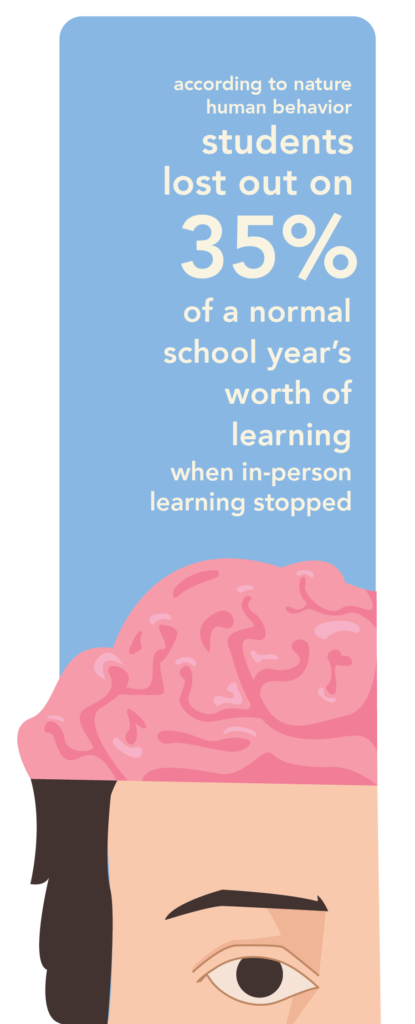Mason staff supports student growth post-pandemic
Kendall Davis | The Chronicle

With the effects of COVID-19’s learning gaps becoming apparent, Mason teachers and administration innovate to move forward in new directions.
Across schools worldwide, teachers and students alike have noticed difficulties with returning to learning and behaving in school post-pandemic. With the shifting of expectations during the COVID years, it has been challenging for students to keep up with the typical pace of content. Mason City Schools (MCS) teachers, administrators and students are all working towards continuing students’ growth.
Teacher’s Academy teacher Marcie Blamer oversees Teacher’s Academy, a program for high school students who plan to have a career in education. She said she has noticed that in her classroom, students have experienced a delay in their social development due to the years students were not at school in-person. She also said that learning obstacles are typically noticed in a school setting.
“We’re missing social-emotional behavior, self-regulation, kids’ ability to regulate their emotions and behaviors,” Blamer said. “We have missed a lot of identification of learning challenges that we could have been addressing before, but when you’re not in a classroom, these are the things you might not know.”
Mason Early Childhood Center (MECC) principal Melissa Bly has been working closely with teachers to create the best pos- sible learning experiences for students both during and after the impacts of COVID by monitoring testing scores and making necessary adjustments. She said that for young children, it was challenging to keep up with the core learning done in early childhood such as learning how to read.
“When we look at the academic data from those years when the kids returned, we do see a little drop in the reading performance,” Bly said. “Definitely being back in school has shown that they can achieve at the levels we would expect at this point.”
Senior Teacher Academy student Ihina Das said that when she worked with fourth and fifth
graders, she observed collaboration issues students would not have had pre-COVID.
“What I noticed is they [the students] wouldn’t interact with each other,” Das said. “They would only do stuff on their own or by themselves.”
Freshman English and Honors English I teacher Jennifer Leitsch said she has seen an uptick in student behaviors that would typically be expected of younger grades, but that teachers can adapt to the needs of students following the online schooling years.
“Behaviors are a little boisterous,” Leitsch said. “That doesn’t mean we don’t do group work anymore. That means we scaffold it differently so that you’re teaching them the behaviors that we want to see.”
Blamer said that another loss from the COVID-impacted years that is still seeing effects is the learning struggles for English language learners.
“A lot of that English language instruction would come from school,” Blamer said. “[It’s hard] when you don’t have that or you’re trying to do that over a computer and you don’t have someone at home that can help you in the language you’re asked to use at school.”
MHS Associate Principal of Teaching and Learning Tina Drake manages many initiatives at the high school to help students repair learning gaps. She said there are many options for students who need support in school such as peer tutoring, connecting with a teacher for support, Comet Connections (an intervention bell at school) and after-school academic intervention program. However, Drake said that the school is always open to expanding the support options available to students.
“We’ve got a lot of systems in place here at the high school to help students,” Drake said. “There are options, and students can self-initiate with their teachers, say, ‘Hey, I’m really struggling.’”
Benchmark assessments are also given to students throughout the school year, which can be used to make sure students are making progress in their learning no matter where they were at the beginning of the year.
Senior Teacher Academy student Hailey Eiserman said that the teacher she has been helping has been finding success with students through different lesson formats that let students socialize with one another.
“My teacher has been having them [the students] do a lot of interactive lessons,” Eiserman said. “She’s having them sit down on the carpet and share with the class one thing they did yesterday or one thing they did over the weekend, and that’s helped a lot.”
Leitsch said that if teachers adapt their expectations for what students should be able to do, it could help promote growth among students.
“[Teachers can work on] shifting their mindset from, ‘These are the skills I have to teach, this is what I’ve always done,’” Leitsch said. “I think [we need to be] shifting the focus to be like, ‘Who’s in my class? What do they need? How do I grow them?’ That attitude shift can make a huge difference.”
Bly said that for younger students, ensuring that they have access to a variety of good literature is a way to make progress.
“All of our classrooms have plentiful libraries of books that are at different reading levels because we want them [the students] to feel really confident,” Bly said. “That helps them to stay engaged when they feel that confidence and feeling like, ‘I’m reading books, just like a grown-up would,’ and achieving that on a regular basis.”
Blamer said that creating interactive and engaging lessons that are unique to in-person situations is key to rebuilding interest and success in a post-COVID school setting.
“The way that we fix this [learning gap], in part, is creating an experience in our classrooms that cannot be replicated,” Blamer said.
